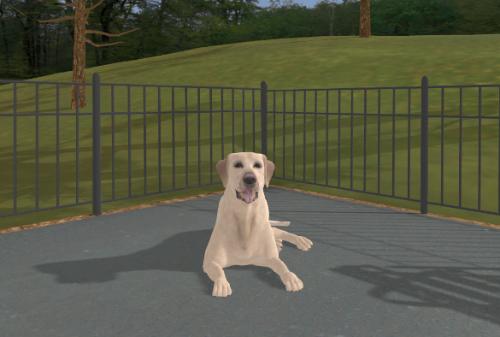Background
Dog bites are a growing public health concern, with previous University of Liverpool research finding that adult hospital admission rates for dog bites tripled in England between 1998-2018. A better understanding of human-dog behavioural interactions could help researchers tackle this growing problem but research using real dogs is fraught with challenges.
Since 2016 the Virtual Engineering Centre (VEC) has been working with Professor Carri Westgarth’s research group in developing a new approach for improving human understanding of canine body language to prevent bites. The Virtual Engineering Centre, in collaboration with Dogs Trust, and the University of Liverpool’s Institute of Infection, Veterinary and Ecological Sciences have created an immersive 3D environment to demonstrate the value of digital technologies in the identification and education around canine body language related to aggression.
The Challenge
Dogs Trust is keen to better educate adults about the identification of early signs of potential aggressive behaviour in dogs, in order to enable better prevention and improve canine welfare. Dogs Trust wanted to help people to identify a range of stress and threat behaviours typically exhibited by dogs which have the potential to lead to a dog biting a person. The charity is therefore interested in understanding whether a digital model could help people to identify these signs and provide the ability to communicate, when a dog may not wish to interact and therefore becomes aggressive. This would help to improve both animal and human welfare in the future.
Dr Carri Westgarth, Chair in Human-Animal Interaction at the University of Liverpool explains “Dog bites are a common public health issue affecting human-dog relationships. Studying human behaviour around a dog performing aggressive behaviours is ethically difficult, for the sake of the risk to the person but also, we don’t want to be deliberately making dogs unhappy. A virtual dog solves these problems.”
The solution

The VEC aimed to create a proof of concept, immersive environment which would support academic research into further preventing dog bites. This could then be used as an educational tool, enabling users to better understand animal behaviour, in particular human-dog interaction and early signs of aggression.
A team of animal behaviourists worked closely with the VEC to make certain that the body language and detail shown in the virtual environment was both realistic and a truthful reflection of real world canine behaviour.
The result was an environment in which people could approach and interact with a dog in a safe and controlled way and highlight hostile signals displayed by the dog which could potentially lead to an attack or incident if not correctly identified.
The immersive Virtual Reality (VR) experience allows a person to approach the dog, and as the person gets closer, the behaviour and body language of the dog gradually changes. The dog’s behaviour begins to display signs of aggression including licking its lips, lowering of the head and body, front paw lifting, growling, and showing of teeth. These behaviours are referenced from the ‘Canine Ladder of Aggression’ which shows how a dog may behave when it does not want to be approached.

The impact
This proof of concept tool has already been used for assessing user reactions and responses, demonstrating that immersive experiences can be used by researchers and organisations such as Dogs Trust to assess human behaviour around dogs in a safe environment and that there is value in developing tools of this nature further.
Next steps will look to develop an educational tool using the virtual environment and enable the software to be used in wider educational contexts. Using VR can help to engage and improve the interest felt within a classroom environment, and the use of VR headsets often helps people to overcome any learning disability or language barrier.
Paula Boyden, Dogs Trust Veterinary Director, said “We were delighted to fund the University of Liverpool DAVE Pilot, its potential to provide a fascinating insight into human-canine interactions is clear. We hope that DAVE will be developed into an education tool to teach people how to be safe around dogs.
Before a bite occurs, a dog will often display subtle behaviours to indicate that it is uncomfortable and does not want to be approached. By educating people about these behaviours, we hope that incidences of dog bites can be significantly reduced."
Seeing the change in the dog’s body language through a realistic immersive environment may accelerate the learning of the user when compared to traditional vocal teaching. Although the simulation can feel very realistic, the virtual environment keeps users safe, allowing them to sense potentially dangerous environments and learn to adopt appropriate behaviours. Future developments will show a wider range of dog behaviours and reactions to user behaviour. These can help to showcase human behaviour and the way in which dogs may find people threatening.
Dr Andy Levers, Executive Director for the VEC and the Institute of Digital Engineering and Autonomous Systems (IDEAS) added “The Virtual Engineering Centre was delighted to be approached to support this exciting project which we believe can really make a difference. This digital tool enables the user to interact and learn with a realistic virtual dog within a safe and controlled sandpit environment, providing an engaging educational experience.
The application consists of features that can be easily customised to offer a more bespoke experience for the needs of the user, such as changing the appearance, size and behaviour of the dog. The combination of virtual techniques provides layers of visual and cognitive realism, allowing the virtual dog to make decisions based on the situation and respond in a similar way to that of a real dog.”


Back to: Research
-min.jpg)
